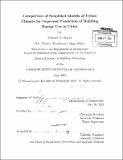| dc.contributor.advisor | Christoph Reinhart. | en_US |
| dc.contributor.author | Street, Michael A. (Michael Anthony) | en_US |
| dc.contributor.other | Massachusetts Institute of Technology. Department of Architecture. | en_US |
| dc.date.accessioned | 2013-11-18T19:04:00Z | |
| dc.date.available | 2013-11-18T19:04:00Z | |
| dc.date.copyright | 2013 | en_US |
| dc.date.issued | 2013 | en_US |
| dc.identifier.uri | http://hdl.handle.net/1721.1/82284 | |
| dc.description | Thesis (S.M. in Building Technology)--Massachusetts Institute of Technology, Dept. of Architecture, 2013. | en_US |
| dc.description | Cataloged from PDF version of thesis. | en_US |
| dc.description | Includes bibliographical references (p. 127-131). | en_US |
| dc.description.abstract | Thermal simulation of buildings is a requisite tool in the design of low-energy buildings, yet, definition of weather boundary conditions during simulation of urban buildings suffers from a lack of data that accounts for the UHI effect. To overcome barriers preventing the use of more representative climate data in building thermal simulations, this thesis evaluates two recently developed methods for generating urban weather files from a rural station. The two methods examined are computationally inexpensive. The first method is the urban weather generator (UWG) a model developed by Bueno et al. and the second is a temperature alteration algorithm developed by Crawley 2008. Actual weather data is used to validate the modeled urban data. Actual and modeled weather data is then used in simulation of a typical single-family and small office building to quantify normalized energy use metrics of urban buildings. Applying the UWG to appropriate rural weather data reduces the error associated with energy prediction of an urban single-family building by nearly half (21% to 13%). If the Crawley algorithm is applied to rural data, the resulting weather data will produce simulation results that are lower (- 8%) and upper limits (+ 11%) to the actual urban energy simulation results. For applications that either require feedback with the urban design or have extensive data on the urban morphology we recommend the use of the UWG with a radius of 500 m. For applications that lack urban site data and are order of magnitude estimations, the Crawley algorithm generally is able to provide extremes of the predicted EUI. | en_US |
| dc.description.statementofresponsibility | by Michael A. Street. | en_US |
| dc.format.extent | 131 p. | en_US |
| dc.language.iso | eng | en_US |
| dc.publisher | Massachusetts Institute of Technology | en_US |
| dc.rights | M.I.T. theses are protected by
copyright. They may be viewed from this source for any purpose, but
reproduction or distribution in any format is prohibited without written
permission. See provided URL for inquiries about permission. | en_US |
| dc.rights.uri | http://dspace.mit.edu/handle/1721.1/7582 | en_US |
| dc.subject | Architecture. | en_US |
| dc.title | Comparison of simplified models of urban climate for improved prediction of building energy use in cities | en_US |
| dc.type | Thesis | en_US |
| dc.description.degree | S.M.in Building Technology | en_US |
| dc.contributor.department | Massachusetts Institute of Technology. Department of Architecture | |
| dc.identifier.oclc | 861228984 | en_US |
